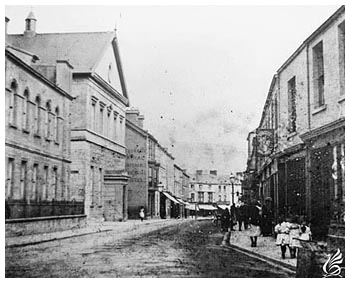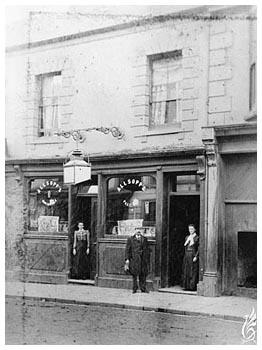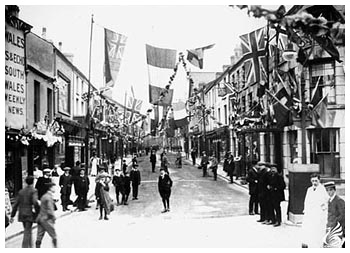
| Canon Street, Aberdare | |
 |
This photograph of Canon Street clearly shows Trinity Chapel and the New Theatre. The New Theatre was originally the Temperance Hall, an important public building in Nineteenth Century Aberdare that was constructed in 1858 at a cost of £3,000, provided by the Total Abstinence Society. The Hall consisted of an auditorium, which could seat 1,500 people, a temperance hotel with 11 rooms, committee, rooms, a library and temperance coffee house. At the time of its construction the Hall was the largest space available in Aberdare to hold public gatherings and was used extensively for public meetings, lectures and entertainment. Left: General View of Canon Street |
| Like all similar towns in the South Wales Coalfield there was a large number of public houses in the Aberdare area. In 1793 there were just five public houses in the parish of Aberdare but by 1872 it has been estimated that at least 273 public houses existed or had existed in the area from Hirwaun to Abercwmboi. The dramatic rise in the population at this time and the culture of drinking associated with the heavy industries that were opening at this time are the primary reasons for this dramatic growth. The public houses of the region served an important role in public life in the first half of the Nineteenth Century. The early eisteddfodau were all held in public houses, most notably that of Carw Coch held at the Stag Inn, Trecynon in 1853. Many early chapels were based in public houses before their congregations could build their own place of worship. For example, in 1836 before the construction of Salem Chapel, Robertstown the Minister Joseph Harrison established a conventicle in the Long Room of the White Lion, Gadlys. However, in the latter half of the Nineteenth Century the public houses faced increased pressure from the temperance movement and the demarcation between drink and religion became much more marked. At this time the eisteddfodau moved from the public houses to the chapels. |
Above: The Carpenters Arms |
Above: Canon Street decorated for the Royal visit
|
From June 25th to June 27th 1912 King George V and Queen Mary visited Cardiff and the South Wales Valleys. On the 27th their itinerary included a visit to Pontypridd and Porth on the Royal Train, followed by a trip in a motor car through the Rhondda Fawr and on to Merthyr Tydfil. In the afternoon they traveled by motor car from Merthyr to Aberdare. In Aberdare Lord Merthyr presented them with an address from the people of Aberdare in a ceremony at Aberdare Park. Over 8,000 children were in attendance at the Park in order to greet the Royal couple. The most famous element of the visit to Aberdare was their excursion to see a miner's cottage. The cottage chosen was at 71 Bute Street, Aberdare and this property is still known as Queen Mary's Cottage. Following the Royal visit the residents of the house, Mr and Mrs Jones, were visited by hundreds of people from across South Wales who were anxious to see the cup from which Queen Mary had drunk. The Aberdare Leader of 6th July 1912 reported that grateful visitors had filled the cup that the King had drunk from with coppers for the Jones' baby. |

